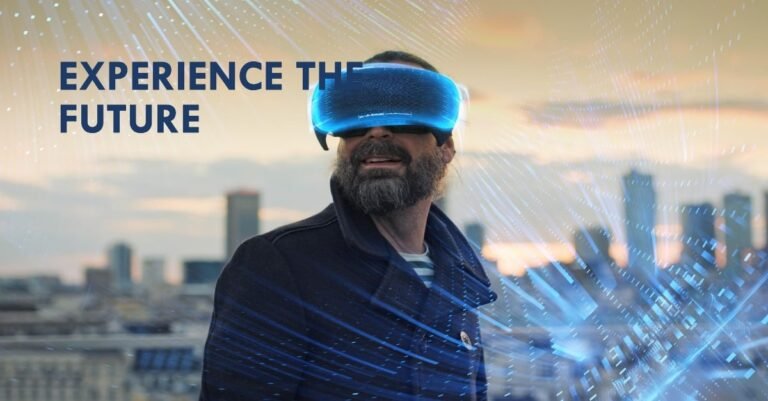Forget 3D Movies! VR is About to Blow Your Mind – Here’s Why!
Remember the craze over 3D movies a while back? Glasses, blurry effects, and maybe a mild headache – it wasn’t quite the revolutionary experience we were promised. But fear not, movie buff! There’s a new sheriff in town, and its name is Virtual Reality (VR). VR is poised to completely transform how we experience cinema, leaving those clunky 3D glasses in the dust.
Forget 3D Movies! VR is About to Blow Your Mind – Here’s why VR is the future of immersive movie watching:
Why are 3D movies no longer a thing?
Let’s face it, 3D movies never quite lived up to the hype. Those flimsy glasses often caused headaches and eye strain. The 3D effect itself could be underwhelming, feeling more like a gimmick than a true enhancement. Forget 3D Movies! VR is About to Blow Your Mind – Here’s Why! because VR offers a complete departure from these limitations.
Limited Depth Perception: 3D movies rely on creating the illusion of depth through stereoscopic glasses. This effect is often shallow and unconvincing.
Discomfort and Strain: Many people experience headaches and eye strain after watching 3D movies for extended periods.
Limited Immersion: 3D movies confine you to a viewer role. You can’t interact with the environment or feel truly present in the scene.
Stepping into the Screen: The Magic of VR Cinema
3D movies attempt to add depth to the screen, but VR throws that idea out the window. Instead, VR places you right in the heart of the action. Imagine yourself soaring alongside dragons in Pandora (Avatar) or feeling the ocean breeze on your face during a high-seas adventure. VR headsets create a completely immersive environment, where you can look around, feel subtle movements, and truly become part of the story.
This isn’t just about a gimmick. VR has the potential to completely redefine storytelling. Filmmakers can create narratives that unfold around them, where you can choose your perspective and explore different aspects of the world they’ve built. It’s like stepping into a living, breathing universe – a far cry from the passive experience of traditional cinema.
What is the difference between 3D and VR video?
3D video and VR video are both technologies designed to enhance the visual experience, but they go about it in fundamentally different ways. Here’s a breakdown to help you understand the key distinctions:
Dimensionality:
- 3D video: Adds depth to a traditional 2D video by providing slightly different images for each eye. This creates the illusion of a three-dimensional space on a flat screen.
- VR video: Creates a fully immersive 360-degree experience. Imagine yourself standing in the center of a sphere, and the video surrounds you. You can turn your head and look around in the virtual world.
Interaction:
- 3D video: You’re a passive observer. You can’t interact with the 3D elements on the screen.
- VR video: Some VR videos allow for a limited degree of interaction. You might be able to control your viewpoint to a certain extent, but you can’t typically walk around or manipulate objects in the VR world.
Content Creation:
- 3D video: Can be filmed with specialized cameras or converted from existing 2D footage.
- VR video: Requires specialized equipment and techniques to capture 360-degree footage or create computer-generated VR environments.
Applications:
- 3D video: Often used in movies, documentaries, and even some sporting events to add a sense of depth.
- VR video: Used in a wider range of applications, including gaming, entertainment (like VR concerts), education and training simulations, and even real estate tours.
Headsets:
- 3D video: Can be viewed on a regular TV with special 3D glasses.
- VR video: Requires a VR headset to experience the full immersive effect.
Here’s an analogy to solidify the difference:
- Think of 3D video like a pop-up book. It adds some depth and dimension to a flat image, but you’re still limited to the page.
- VR video is like stepping into that pop-up book. The world surrounds you and can explore it from different angles.
Ultimately, 3D video offers a slightly enhanced viewing experience on a traditional screen. VR video, on the other hand, transports you to a whole new world, offering a level of immersion that 3D simply can’t match.
Advantages of VR over 3D Movies
Here’s a breakdown of why VR surpasses 3D movies in every way:
- Deeper Immersion: VR goes beyond creating a 3D illusion. It transports you entirely into the movie’s environment, making you feel like you’re truly there.
- No More Eye Strain: Those headaches you might get from 3D glasses? Gone! VR uses natural depth perception, eliminating the need for uncomfortable glasses.
- Greater Emotional Connection: Feeling more invested in the story? VR allows you to form a deeper emotional connection with characters and situations because you’re not just watching – you’re experiencing them firsthand.
- Interactive Potential: While still in its early stages, VR has the potential for interactive storytelling. Imagine being able to influence the plot or explore different paths within the movie’s world.
From Hype to Reality: The Future of VR Cinema
VR cinema is still evolving, but the progress is exciting. Here at ARVRRealm, we’re keeping a close eye on developments:
- Content Creation: Movie studios are starting to experiment with VR experiences, with some even creating VR-specific content. As VR headsets become more affordable and accessible, we can expect a surge in VR movie production.
- Technological Advancements: VR headsets are constantly getting lighter, more powerful, and more comfortable. This will make VR cinema a more seamless and enjoyable experience for everyone.
- Accessibility: The cost of VR headsets is steadily decreasing, making VR technology more accessible to the general public. This will undoubtedly lead to wider adoption of VR cinema in the future.
Can 3D movies be watched in VR?
Yes, actually! While VR offers a far more immersive experience than 3D movies, you can watch 3D movies in VR under certain conditions. Here’s the breakdown:
- VR headsets are compatible with 3D formats: The good news is that VR headsets can display content in 3D formats. They achieve a more natural depth perception compared to 3D glasses because each eye sees a separate image directly.
- Finding 3D content for VR requires effort: Here’s the catch. Most VR content is not inherently 3D movies. There isn’t a vast library of 3D movies specifically designed for VR.
- Workarounds to watch 3D movies in VR: There are a couple of ways to watch regular 3D movies in VR:
- Specific VR apps: Some VR apps, like Bigscreen, allow you to play 3D movies in a virtual theater environment. You’ll need to have the 3D movie file (usually in formats like MP4, MKV, or AVI) downloaded on your computer and then access it through the VR app.
- VR streaming software: You can also use VR streaming software like Virtual Desktop to stream your 3D movie from your PC directly to your VR headset. This allows you to watch the movie on a giant virtual screen within VR.
In short: While VR can technically play 3D movies, it’s not the most straightforward process. If you’re looking for the mind-blowing immersion VR offers, exploring native VR content is the way to go. But if you have a specific 3D movie you want to experience in VR, there are workarounds available.
Addressing Common VR Concerns
While VR technology is rapidly advancing, some potential users might have concerns. Let’s address a few of the most common ones:
Cost: VR headsets can range in price, but some cutting-edge models can be expensive. However, the cost is steadily decreasing as VR technology becomes more mainstream.
Content Availability: The VR movie and entertainment library is still growing, but new content is being released all the time. Additionally, VR experiences go far beyond movies, encompassing gaming, educational experiences, and even virtual travel.
Motion Sickness: Some people experience motion sickness when using VR, especially in fast-paced experiences. However, this is becoming less common as VR technology improves, and there are techniques to help mitigate it.
Stepping into the VR Revolution: How to Get Started
Ready to ditch the dimming lights and popcorn for a truly mind-blowing cinematic experience? Here’s how to get started with VR:
- Choose Your Headset: There are several VR headsets available, each with different features and price points. Do your research to find one that fits your budget and needs. (ARVRRealm has a great guide to choosing the right VR headset – check it out!)
- Find VR Content: There’s a growing library of VR content available, including movies, games, and experiences. Explore streaming services, app stores, and online retailers to find something that piques your interest.
- Dive In! Once you have your headset and content, it’s time to explore the wonders of VR. Put on your headset, follow the setup instructions, and prepare to have your mind blown!
FAQs
I don’t have a VR headset. Are VR movies still worth it?
VR experiences are undeniably superior, but there’s still a place for traditional cinema. That being said, VR headset prices are coming down, and the investment is sure to pay off as VR content continues to grow.
Does VR make you nauseous?
Some people might experience motion sickness initially, especially with fast-paced content. However, VR technology is constantly improving to minimize these effects, and most users adjust quickly.
What kind of VR headset do I need for VR movies?
Any modern VR headset with a decent display and head-tracking capabilities will suffice. Popular options include the Meta Quest 3 and the Apple Vision Pro.
Is VR safe?
VR is generally safe for most people, but there can be some potential side effects like nausea and dizziness, especially for first-time users. It’s important to take breaks and listen to your body.
Do I need a powerful computer for VR?
The processing requirements for VR vary depending on the headset. Some high-end headsets require a powerful gaming PC, while others are standalone devices.
What kind of content is available in VR?
There’s a wide range of VR content available, including movies, games, educational experiences, social platforms, and even fitness applications.
So, Ditch the 3D Glasses – Embrace VR!
While 3D movies had their moment, VR offers a revolutionary leap forward in cinematic experience. From unparalleled immersion to the potential for interactive storytelling, VR is poised to become the future of how we watch movies. Are you ready to ditch the 3D glasses and step into a whole new world of cinema? With VR technology rapidly developing, it won’t be long before you can experience the magic of VR movies yourself. Stay tuned to ARVRRealm as we explore the latest advancements in VR cinema and keep you up-to-date on this exciting new frontier in entertainment!






